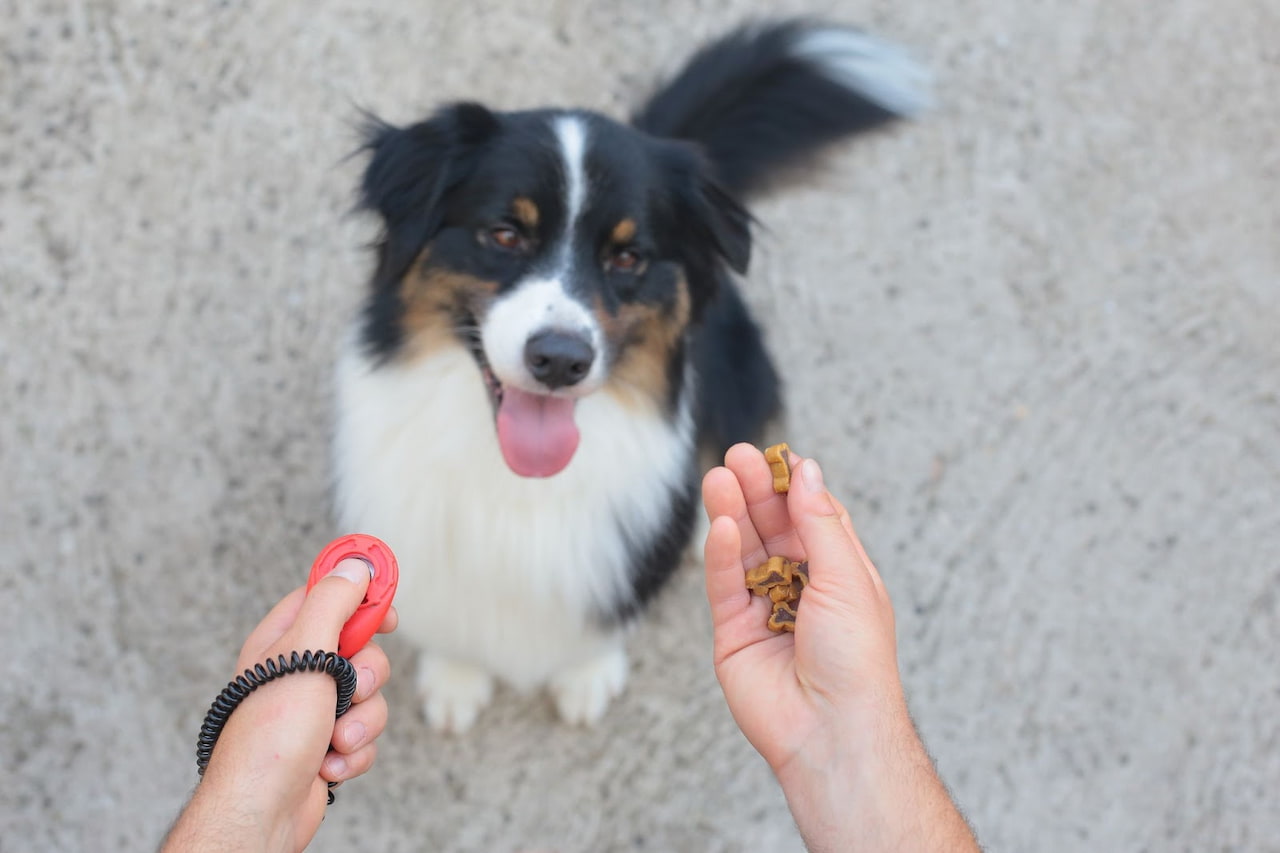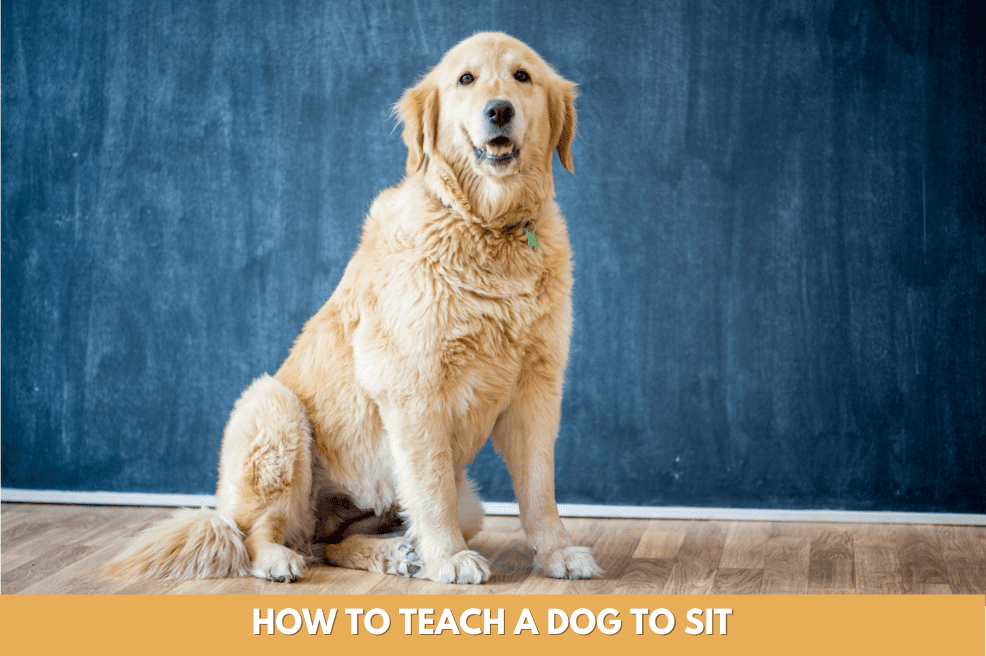You must train your pup “sit” as a dog owner. It improves your bond with your dog and helps ensure their safety in various situations. We’ll show you how to teach a dog to sit in this thorough guide.
Sitting is the basis of dog training. When meeting new people or crossing the street, you can manage your pup by training them to sit. Teaching your pup to sit improves their demeanor and loyalty, making other training easy. Training your dog to sit is a lifelong task.
Why Teach Your Dog to Sit?
Training your pup to sit is crucial. It is one of the most important orders your pup should learn. First and foremost, teaching your dog to sit helps to establish you as the pack leader, as you are the one giving the commands. It also prevents bad behavior like leaping on people or fleeing off. In public and around other dogs, teaching your pup to sit can make them easier to handle. It can also be used in emergencies to keep your pup in one spot.
Benefits of Teaching Your Dog to Sit
Here are 7 perks of training your pup to sit:
- Promotes obedience: Sitting is one of the first steps to teaching your pup basic orders.
- Enhances safety: A dog that knows how to sit on command is less likely to run into dangerous situations or cause harm to others.
- Builds communication: When you teach your dog to sit, you’re building a foundation for clear communication and establishing a positive relationship with your pet.
- Reduces anxiety: Sitting can help calm an anxious dog and make them feel more secure in new or stressful situations.
- Enhances focus: Sitting on command can help your dog focus on you and other training exercises, making it easier to teach them new skills.
- Increases socialization: A well-trained dog that can sit on command is more likely to be welcome in public spaces and around other people and pets.
- Strengthens bond: Training your dog to sit and rewarding them for good behavior can deepen the bond between you and your furry friend.
When a Dog Should Sit?

Here are some important situations when dogs should sit:
- Greeting people: Teaching your dog to sit when greeting people can prevent jumping and make interactions with new people more pleasant.
- Waiting at doors: Dogs that sit and wait at doors are less likely to bolt through them and potentially harm themselves or others.
- During meals: A dog that sits patiently during mealtime is less likely to beg for food or become a nuisance during dinner.
- At the vet’s office: Dogs that can sit calmly at the vet’s office are less likely to become nervous or uneasy, making the experience less upsetting for both dog and owner.
- Before crossing the street: A dog that sits before crossing the street is less likely to run into traffic or cause an accident.
- During training exercises: Sitting on command can help your dog focus during training exercises and make it easier to teach them new skills.
- During grooming sessions: Teaching your dog to sit during grooming sessions can make the process more comfortable for them and easier for you.
- In crowded places: A dog that sits calmly in crowded places like parks or festivals is less likely to become overwhelmed and potentially aggressive.
PROFESSIONAL TIP: To reinforce good behavior when teaching your dog to sit, be sure to use positive reinforcement such as treats and praise. This will make the training process more enjoyable for your dog and encourage them to continue following your commands in various situations.”
Supplies for Teaching a Dog to Sit
Treats
Using treats as positive reinforcement is one of the most common and effective ways to teach dogs to sit. The key is to reward your dog immediately after they sit on command. You can use small, bite-sized treats or even a portion of your dog’s regular food as a reward. Gradually reduce the amount of treats you use as your dog becomes more proficient in the behavior.
Clicker
A clicker is a handheld device that makes a distinct sound to signal good behavior. When you click the device, it marks the exact moment your dog performs the desired behavior. You can then reward your dog with a treat immediately after the click. Clicker training is especially useful for teaching dogs complex behaviors such as agility courses or tricks.
Target Stick
You can teach your pup to sit with a target stick. The stick usually has a ball or other object on the end that your dog can touch with their nose or paw. You can hold the target stick above your dog’s head and lead them into a sitting position, then reward them with a treat. Over time, your dog will learn to associate the target stick with the desired behavior.
Harness
Your pup can be softly guided into a seated posture with a collar. The leash-attached collar goes over your dog’s back. Simply lift up on the harness, prompting your dog to sit, and then reward them with a treat. Harnesses are especially useful for teaching puppies and smaller dogs who may not respond well to physical manipulation.
Step-by-Step Guide on How to Teach a Dog to Sit
How To Teach A Dog Sitting By Lure
Lure training is a positive reinforcement technique that uses food or other rewards to encourage dogs to perform desired behaviors. The basics of lure training involve using a treat to guide your dog into the desired position, and then rewarding them with the treat once they perform the behavior. This technique can be used to teach a variety of behaviors, including sitting.
Step 1: Make Your Pup Sit
Start by holding a treat in your hand and showing it to your pup. Move the treat above the dog’s head and say the word “sit.” As your dog follows the treat with their nose, their back end will naturally lower into a sitting position. Once they are fully seated, praise your dog and give them the treat.
Step 2: Once in a sit, praise your dog!
As soon as your dog is in a sitting position, praise them enthusiastically and give them the treat. This reinforces the habit and makes it more likely to happen again.
Step 3: Adding a Verbal Cue for Sit
After your dog has learned to associate the treat with the behavior of sitting, it’s time to add a verbal cue. As you move the treat above your dog’s head, say the word “sit” at the same time. This will help your dog learn to associate the verbal cue with the behavior.
Step 4: Repeat this process.
Repeat this process several times until your dog consistently sits on command. Be patient, and remember to praise and reward your dog each time they perform the behavior correctly.
Step 5: Practice with a Hand Signal
Once your dog has learned to sit on command with the verbal cue, you can start to incorporate a hand signal. Keep your palm out and your fingers up like you’re telling someone to halt. As you give the verbal cue, use the hand signal at the same time. This will help your dog learn to associate the hand signal with the behavior of sitting.
Step 6: Start to Fade Out Training Treats
As your dog becomes more proficient in the behavior of sitting, you can start to fade out the training treats. Begin by using the treats less frequently, and eventually only reward your dog with praise and affection when they sit on command.
Step 7: Practice in Different Locations
Once your dog has mastered sitting on command in a familiar location, it’s time to practice in different locations. This will help reinforce the behavior and teach your dog that the command applies in any environment.
Read on for more commands:
22 Commands Basic to Advanced for Your Dog
How To Teach A Dog Sitting By Clicker

Clicker training is a positive reinforcement technique that uses a handheld device to make a distinct sound when your dog performs a desired behavior. The sound of the clicker is immediately followed by a reward, such as a treat, to reinforce the behavior. Clicker training is a popular and effective method for teaching dogs a variety of behaviors, including sitting. The basics of click training involve marking the behavior with the sound of the clicker, followed by a reward.
Step 1: Charge the Clicker
Before you can start clicker training your dog, you need to charge the clicker. To do this, simply click the device and immediately give your dog a treat. Repeat this process several times until your dog associates the sound of the clicker with a reward.
Step 2: Lure Your Dog into a Sit
Hold a treat in your hand and move it above your dog’s head. As your dog follows the treat with their nose, their back end will naturally lower into a sitting position. As soon as their bottom touches the ground, click the clicker and give your dog a treat.
Step 3: Repeat the Process
Repeat the process of luring your dog into a sit and clicking the clicker immediately followed by a treat several times. This will help your dog learn to associate the sound of the clicker with the behavior of sitting.
Step 4: Add a Verbal Cue
It’s time to add a vocal cue to your dog’s clicker training after he’s learned to sit. As you move the treat above your dog’s head, say the word “sit” at the same time. When your dog sits, click the clicker and give them a treat.
Step 5: Practice with Verbal Cue
Practice the behavior of sitting with the verbal cue, “sit,” and the clicker. Be consistent with the verbal cue and clicker timing, clicking as soon as your dog sits and rewarding them immediately with a treat.
Step 6: Practice Without Treat Lure
Gradually reduce the use of the treat lure and rely more on the verbal cue and clicker. Click and treat your dog every time they sit on command, even if you didn’t use the treat lure.
Step 7: Practice in Different Locations
Once your dog has learned to sit on command with the clicker and verbal cue, practice the behavior in different locations. This will help reinforce the behavior and teach your dog that the command applies in any environment.
How To Teach A Dog To Sit From Down Position
Here are the steps to teach a dog to sit from a down position:
- Start with your dog in a down position.
- Hold a treat in front of their nose and slowly move it up and towards their back end.
- As your dog follows the treat with their head, their rear end should naturally lift off the ground and move into a sitting position.
- As soon as your dog sits, click a clicker or use a verbal marker such as “yes” to signal the behavior you want.
- Reward your dog with a treat or praise immediately after marking the behavior.
- Practice this sequence repeatedly until your dog sits reliably from a down position.
- Add a verbal cue such as “sit” as you lure your dog into the sitting position.
- Gradually reduce the use of the treat lure and rely more on the verbal cue and clicker.
- Practice in different locations and with distractions to help your dog generalize the behavior.
- Always use positive reinforcement to encourage good behavior and be patient with your furry friend as they learn.
How To teach A Dog To Sit And Stay
Here are the steps to teach your dog to sit and stay:
- Start with the “sit” command. Use a treat or other reward to lure your dog into a sitting position, and use a clear verbal cue such as “sit.”
- Once your dog is sitting, use a clear hand signal such as a flat palm facing towards your dog to signal the “stay” command.
- Click a clicker or use a verbal marker such as “yes” to signal the behavior you want, and reward your dog with a treat or praise.
- Gradually increase the duration of the “stay” command. Start with a few seconds and slowly raise the time your dog sits.
- Add distance to the “stay” command. Start by taking a step back from your pup, then steadily increase the space as they get used to the behavior.
- Practice the “stay” command in different locations and with distractions. This will help your dog generalize the behavior and understand that the command applies in any environment.
- Release your dog from the “stay” command with a verbal cue such as “okay” or “release.”
- Always use positive reinforcement to encourage good behavior, and be patient and consistent with your training.
Tips for Teaching Your Dog to Sit
Here are some tips for teaching dogs to sit:
- Use positive reinforcement such as treats, praise, or toys to encourage good behavior.
- Choose a clear and consistent verbal cue for the “sit” command.
- Start with 5–10-minute exercise routines several times a day.
- Use treats as lures to guide your dog into the sitting position.
- Use clicker training to signal when your dog has done something right.
- Practice in different locations and with distractions.
- Be patient and consistent with your training, and always use positive reinforcement to encourage good behavior.
How to Use Your Dog’s Sit Cue in Real Life
Sitting on command is essential to dog obedience training. It’s equally essential to know how to use the “sit” cue in real life.
Use your dog’s “sit” cue in real life with these tips:
- At mealtime: Before you give your dog their food, ask them to sit first. This helps establish good manners and can prevent them from jumping up or rushing towards their food.
- At the door: When someone comes to the door, ask your dog to sit and stay before opening the door. This can prevent them from rushing out and potentially getting hurt or lost.
- During walks: Ask your dog to sit and wait at every street corner before crossing the street. This ensures that your dog is paying attention and will prevent them from running into traffic.
- When greeting people: If your dog tends to jump up on people when greeting them, ask them to sit first before allowing them to say hello. This teaches your dog to be polite and can prevent accidents or injuries.
- In the car: Before allowing your dog to enter or exit the car, ask them to sit and wait. This can prevent them from bolting out of the car and potentially getting hurt or lost.
Things To Avoid When Teaching Dogs To Sit
Avoid these things when training your pup to sit to avoid confusion or frustration. Mistakes to avoid when training your pet to sit:
- Punishing your dog: Punishing your dog for not sitting can create fear and confusion, which can make the training process more difficult.
- Using force: Forcing your dog into a sitting position can be uncomfortable and scary for them, and can also make the training process more difficult.
- Overuse of treats: While treats can be a useful tool for training, relying too heavily on treats can create dependency and may lead to obesity.
- Inconsistency: Inconsistency in your verbal cues, hand signals, and rewards can confuse your dog and make it difficult for them to learn.
- Rushing the process: It’s important to take your time and go at your dog’s pace when teaching them to sit. Rushing the process can create frustration and confusion for your dog.
Troubleshooting Common Issues
Dog won’t sit
- Ensure that you’re using a clear verbal cue and hand signal.
- Use a treat or other lure to guide them into the sitting position.
- Reward them for good behavior.
If your pup won’t sit, they may not comprehend your command. Make sure you’re using a clear verbal cue and hand signal, and that you’re rewarding them for good behavior. You may also need to use a treat or other lure to guide them into the sitting position. If your dog still isn’t sitting, consult with a professional dog trainer or behaviorist for additional support.
Dog won’t stay
- Gradually increase the duration of the stay.
- Use a verbal cue such as “stay” and reward them for staying in position.
Your pup may not be keeping in the seated posture because they haven’t learned the “stay” command. Start by gradually increasing the duration of the stay. Use a clear verbal cue such as “stay” and reward them for staying in position. With practice, your pup will sit longer.
Dog easily distracted
- Practice in a quiet and familiar environment before gradually increasing the distractions.
- Use a treat or toy to redirect their attention back to the task at hand.
If your dog is easily distracted, it’s important to start training in a quiet and familiar environment before gradually increasing the distractions. You can also use a treat or toy to get their focus back on the job. With practice, your dog will learn to focus on you and the training exercises, even in distracting environments.
Dog afraid
- Go at their pace and use positive reinforcement to encourage good behavior.
- Consult with a professional dog trainer or behaviorist for additional support.
If your pup is scared or nervous, go at their pace and use positive rewards to promote good behavior. You may also need help from a dog teacher or behaviorist. With patience and consistent training, you can help your dog overcome their fears and learn to sit on command.
Dog jumping up instead of sitting
- Turn away and ignore them until they settle down.
- Use a treat or other lure to guide them into the sitting position.
If your dog is jumping up instead of sitting, it’s important to turn away and ignore them until they settle down. Then, use a treat or other lure to guide them into the sitting position. With consistent training, your dog will learn that jumping up is not an acceptable behavior, and will start sitting on command instead.
Conclusion
As we finish this thorough guide on how to teach a dog to sit, remember that every dog is unique and may require different training methods and tactics. While some dogs may respond well to food rewards, others may prefer praise or a favorite toy as a reward for good behavior. It’s important to remain patient and adaptable throughout the training process, and to always prioritize positive reinforcement over punishment.
You can help your pet be well-behaved, loyal, and safe by following this guide’s advice. Whether you’re teaching your pup to sit for the first time or repeating their training, constancy and patient are key. With devotion and persistence, you can teach your pup to sit on order and enjoy the benefits of a well-trained and loyal friend.
FAQs When Training Dogs To Sit
Can all dogs learn to sit?
Yes, all dogs can learn to sit regardless of breed, size, or age. It is a basic command that can be taught to any dog with patience, consistency, and positive reinforcement training.
How old does a puppy need to be to learn how to sit?
Puppies can begin learning basic commands such as “sit” as early as 8 weeks old. However, their attention span may be short, so training sessions should be brief and frequent.
How do I train a stubborn puppy to sit?
If your puppy is stubborn, try using high-value treats as a reward and breaking the training down into smaller steps. For example, lure your puppy into a sitting position with a treat, and then gradually decrease the amount of luring until your puppy can sit on command without the treat.
What are the best ways to teach my puppy to sit?
The best way to teach your puppy to sit is through positive reinforcement training. Use treats or toys to reward your puppy when they successfully perform the command, and be patient and consistent with your training. Luring with treats and using a clicker can also be effective methods.
How long does it take to teach a puppy to learn how to sit?
The amount of time it takes to teach a puppy to sit can vary depending on the dog’s age, breed, and personality. However, with consistent training, most puppies can learn to sit within a few weeks to a few months.
Can I teach my dog to sit without treats?
Yes, you can teach your dog to sit without treats. However, it may be more challenging, as treats are a primary motivator for most dogs during training. You can use verbal praise or a favorite toy as a reward instead.
Can I teach a senior dog to sit?
Yes, senior dogs can also learn basic commands such as “sit” with patience and positive reinforcement training. However, it may take more time and effort compared to teaching a younger dog.
How can I teach a dog to sit from the “down” position?
To teach your dog to sit from the “down” position, first, have them lie down, and then hold a treat close to their nose and slowly move it upwards. As your dog follows the treat with their head, their hindquarters should naturally rise into a sitting position. When your dog sits, reward them with the treat and praise. Repeat this process until your dog can sit on command from the “down” position.


